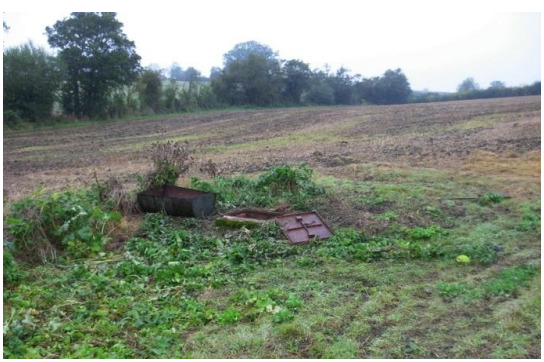Contamination event due to insufficient source protection
This case study relates to a small, rural, spring supply serving five owner occupied dwellings and a business centre where the occupiers are tenants. The supply originates from a spring located in a field used to grow crops and also comprises contingency arrangements in the form of a backup mains supply connection. The estimated daily usage is 5m³ for domestic purposes.
Figure 10: Location of spring chamber in field

In October, the farmer who owns the field hired contractors to spread bio-solids (sludge cake) on his farm. When the contractor arrived to undertake the task, he misunderstood his instructions and applied sludge cake to the field where the spring was located. At the time the spring was obscured by long grass. Next day, the farmer was contacted by two users of the supply who both reported an unusual odour in their tap water. In response, the farmer advised all of the users not to drink the water. He arranged for the spring to run to waste and for the connection to the public supply to be opened. He also notified the local environmental health officer who attended the site later the same day. The ‘do not drink’ advice was formalised in a Regulation 18 Notice, samples were taken and the water company was informed.
The results of samples taken from kitchen taps were satisfactory confirming the back up mains supply was of good quality. The spring source sample contained >100 coliforms and four E.coli per 100ml. The water company confirmed that the bio-solids had been lime treated, deactivated and microbiologically tested prior to spreading on the field using the correct method of application; however, no exclusion zone had been put in place around the spring. Fortunately, in this instance, given the nature of the bio-solids, there was no long-term contamination of the spring as a consequence.
The water company flushed the distribution pipework with chlorinated water and took further samples for a wider range of chemical parameters throughout the supply. The results of these samples later proved satisfactory. The water company also advised the farmer on improvements he could make to the treatment of the spring supply. Prior to reinstatement, the farmer installed an ultraviolet (UV) treatment unit on the spring supply.
A year prior to this event, the local authority had risk assessed the supply as they were required to do by the Private Supply Regulations. The application of bio-solids to the land had been identified as a hazard, but the risk was considered low as the frequency of applications was less than once a year. Other relevant hazards recorded were the construction of the spring chamber (which did not serve as a barrier to prevent the ingress of surface water), and the absence of a lockable cover to prevent unauthorised access to the spring. Due to satisfactory sample results for a limited range of parameters, the local authority had given only informal advice to the owner (remove the sediment from the spring and replace the cover on the spring pit with a lockable one). It was the intention of the local authority to check that these actions had been carried out when they returned for the next annual sampling visit.
The root cause of this water quality event was a human error, which revealed that the source protection arrangements were not sufficiently robust to safeguard the supply. This case study provides practical evidence of the benefits of relatively simple safeguarding measures such as fencing off sources located in fields. If the local authority had formalised the findings of the risk assessment in the form of a written action plan with requirements for appropriate and timely validation by the owner, this event may have been prevented. The Inspectorate has noted that some local authorities are still placing too much reliance on sample results as the primary basis of their decision making, whereas, as this case study shows, satisfactory sample results do nothing to safeguard a supply from hazards that are left unmitigated.
